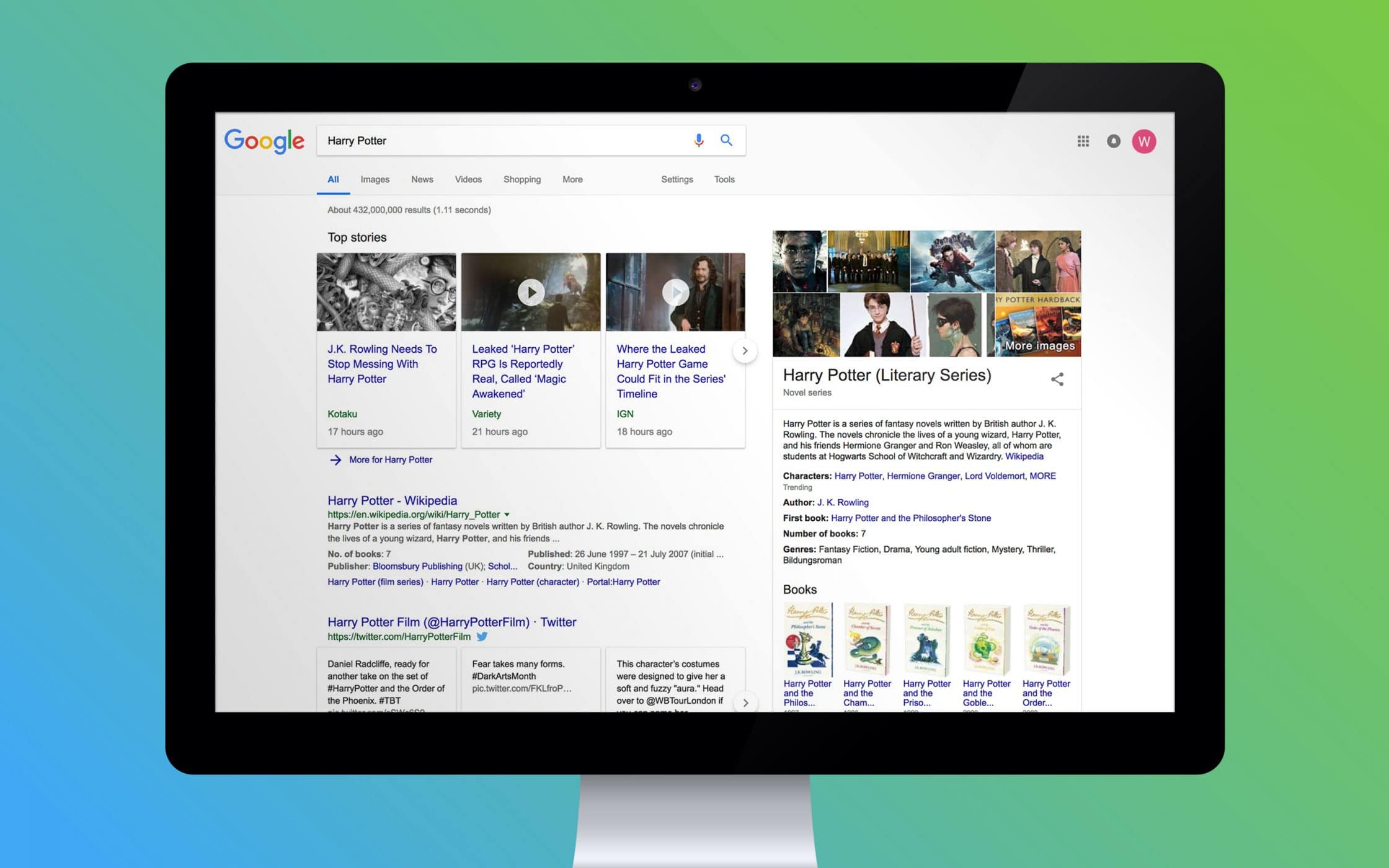What is semantic search? Reading between the lines for your SEO strategy

Businesses and marketing experts spend a lot of time and money learning to speak the language of search engines like Google.
We know that if we want to connect with our target audience, we need to get on Google’s good side first. After all, the internet is a vast and often confusing place. Search engines are the tour guides that tell your potential customers where to go, how they can solve their problems and who they can trust.
In the past, befriending Google was as simple as a basic math equation. Companies entered the keywords, combined them with useful data for the search engines to index, and hey presto – they had a successful site. However, as the internet becomes a more pervasive part of our daily lives, and customers expect more from their online experience, search engines are getting smarter.
Machine learning algorithms and the rise of semantic search have made Google increasingly human, to the point where it’s starting to understand things like sentiment and context.
Today’s brands need more than just the right combination of short tail and long tail keywords to thrive. You need to understand precisely what your audience is looking for and discover how you can convince the search engines that you have the answers to your customer’s questions.
Today, we’re going to explore the complex world of the semantic search engine. By the time you’ve finished reading, you’ll know:
- Where the semantic search algorithm began.
- How you can prepare your website for semantic search.
- What you can do to optimise your content for Google semantic search.
Let’s get started.

What is semantic search? Demystifying the semantic search algorithm
First things first: what is semantic search?
The Merriam Webster dictionary defines ‘semantics’ as the linguistic study of meaning. In other words, it’s about understanding what people mean when they talk, not just by looking at the words, but by analysing the context, sentiment, and intent of each sentence.
Semantic search is an SEO (search engine optimisation) strategy that aims to improve search engine accuracy by unlocking the meaning of the terms they search for.
The semantic search engine began when Google implemented its ‘Hummingbird’ update in 2013. The system used searcher intent and context to ensure that they showed users the pages that answered their questions, rather than ranking sites that share a few matching terms.
The Google semantic search solution continued to develop in 2015 when ‘RankBrain’ emerged. Similarly to Hummingbird, the purpose of RankBrain was to improve the search experience. However, while Hummingbird was a Google algorithm, RankBrain is a machine learning system that attempts to interpret queries by analysing the pages in the Google index and looking for essential features like related terms.
Ultimately, Google’s Hummingbird algorithm and the RankBrain AI work together to collect more contextual data for each search – thereby improving the results that users get, when they search for something online. With semantic search, engines like Google can go beyond keywords as ranking factors, and look at other important elements like:
- Search history: The things a person searched for in the past can indicate what kind of results they might like to see in the future.
- Location: By evaluating user location, Google can provide results relevant to a specific geographical space.
- Query characteristics: Such as spelling variations and co-occurrence of terms like “cook, bake, make”.
Perhaps the simplest way to answer the question “What is semantic search” is this: It’s a way for Google and other search engines to provide better results for their users. The more context Google can add to a search query, the more relevant the results will be.
Semantic search examples: How semantic search works
Semantic search might seem like a way of making SEO more complex. However, it’s Google’s way of improving the digital experience for users and brands alike. Customers get results that are tailored to their specific needs, while brands can avoid competing for organic traffic based solely on the number of times they can fit a particular keyword into their website.
The semantic search engine knows user history, understands common meanings, and uses a combination of logic and intent to deliver answers to customer questions quickly and efficiently. For marketers, this simply means that getting ahead of semantic web search is all about moving beyond the traditional meaning of words and phrases. With semantic search, you strive to understand the motivation behind search requests. This even means that misspelled words and phrases won’t stop people from getting the results they need:

Let’s explore some semantic search examples, to help you answer the question: “What is semantic search?”
1. Conversational queries
Sometimes, the easiest way to find what you’re looking for online is to ask Google a question with long-tail keywords. Thanks to semantic search, when we search for something like “How do I make enchiladas” we don’t just get a list of results that include the key phrase: “how do I make.” That would make finding the information we needed practically impossible.
Instead, Google understands the full intent of the question and presents useful information accordingly. It even shows some of the essential information you might need at the top of the results:

2. Linked Data
Another way that the semantic search algorithm works on Google is to pull together useful information from an interconnected network of data. For instance, Google’s Knowledge Graph is a gigantic database that Google uses to enhance the search results by adding useful facts to top of your results page. For example, search for “Harry Potter” and on the right side of the SERPs you’ll see this:

The linked data ensures that you not only get a fundamental insight into the topic you’re looking for but a complete overview of any useful information that might help you find what you need.
3. Voice search
Another example of how Google semantic search is changing the SEO landscape is through voice search. Apple’s Siri, Google’s home devices, and a wide range of similar virtual assistants now allow consumers to search for what they need online using their voice. For instance, if you want to make a hotel reservation, all you need to do is ask Google to find and book a room for you verbally.
Most people use different words when they speak than they do when they type. This means that the semantic search algorithm needs to tap into its existing knowledge about sentiment, slang, and even dialect to provide the right results. As audio searching and branding become more popular, semantic web search will continue to be a crucial part of SEO.

How to prepare your website for Google semantic search
Now you know the basics of how semantic web search works, it’s time to figure out how you can use it as part of your SEO strategy.
Adding semantic search tactics to your marketing plan is vital for many reasons. Most importantly, when you learn how to manipulate the semantic search algorithm, you increase your chances of appearing at the top of the search results for the right keywords. This means:
- More organic traffic.
- More clicks.
- More page views.
- More potential conversions.
Google semantic search is the way forward for any business that wants to generate the most attention possible for their website. As older SEO strategies grow obsolete, it’s essential to ensure that your site is optimised for the future of digital search. Here are a few things you can do to make sure that you’re not falling behind on the times.
1. Create user / customer personas
Semantic search is all about understanding your users and presenting them with the information that they’re looking for. If you want to base your content around intent, then you’ll need to get into the minds of your target audience. The easiest way to step into customer shoes is to create a buyer persona that provides you with all the information you need about your leads.
User personas highlight helpful information about your target audience that may help you to understand how you need to structure your semantic search engine strategy. For instance, if you know your audience is younger, local people, then you can adjust your keyword strategy to include common slang and regional terms.
Analytics and A/B testing will help you to build a better overview of your ideal customer based on critical characteristics like location, gender, and age. The more you know about the people you’re trying to connect with, the easier it is to choose the ideal keywords and phrases for your semantic search strategy.
2. Research semantic keywords carefully
Importantly, the semantic search algorithm looks at a lot more than just keywords when deciding where to rank websites. However, that doesn’t mean that keyword research isn’t necessary. For your pages to rank on Google, they still need a keyword focus. The difference is that semantic keyword search strategies are more complicated than most people think. To find keywords for the semantic search engine:
- Create a list of stem or core keywords: Use short-form “head” terms to list level 1 keywords that can inspire the rest of your strategy. For example, a core keyword for Fabrik might be ‘brand’.
- Expand your list to include thematically relevant keywords: Once you have your core keyword, think of other terms that customers might use to search for similar information. For instance, as well as “brand” people may search for: marketing, business, or logo.
- Generate keywords that answer searcher questions: Finally, think about what kind of information your customers would look for relating to those stem keywords. The aim is to answer common questions your audience might have, like: “How do I build an effective brand“.
With your user personas on hand, you can decide which questions are most likely to be relevant to your audience. For instance, if you’re a B2B branding company, you might know that your customers already know the answer to “What is a logo?” but they don’t know “How to design an effective logo”.
3. Use schemas and linking to help Google understand your site
Often, semantic search strategies come down to ‘understanding’. You need to understand your customers, and what they need from your company. On the other hand, Google needs to understand your website and what it offers so that it can rank you appropriately.
The best way to simultaneously communicate with Google and your target audience is to create engaging content that delivers value to your end user. However, you can also get a little technical, and use the ‘schema markup’ on your website to make semantic connections across your site.
Another great way to make your site more semantic web search friendly is with internal linking. Linking to relevant pages within your site whenever you create a new page helps to form connections on your website and give context to your content. Just remember:
- Don’t use internal links in every sentence.
- Make sure the anchor text is relevant.
- Mix internal links with external links to give your site more credibility.

How to align your content with semantic web search
Okay, you know the answer to “What is semantic search,” and you know how to adjust your web design strategy according to the semantic search algorithm.
Now we come to the complicated part: creating the content your customers are searching for.
The Hummingbird update transformed the way Google analyses search queries for good. Instead of looking at what your customers search for as individual words, the algorithms attempt to discern the meaning behind every phrase. This means that if you want to optimise your content for Google semantic search, you need to focus on meaning, relevancy, and depth.
The following tips will help:
1. Create context
Context is at the heart of semantic search. It’s the information that helps the search engine to understand what you’re writing about. A few ways to define greater context in your copy include:
- Combine your semantic keywords with companion words: For instance, if you were writing an article about “Apple,” the search engine might get confused and rank you according to your ability to help customers looking for information about fruit. However, if you combine the core keyword “Apple” with companion words like Mac, computers, technology, and so on, Google can see that you’re talking about Apple the brand, not apple the food.
- Use synonyms and variations of your main phrase: Different people search for things in different ways. When the semantic search algorithm crawls through your copy, it will be looking for as much information as possible to help it rank your content. If your main phrase is “How to create an online presence” using variations like “How to create a website” or “How to build an online presence” will give Google more data to work with.
- Link to relevant pages: As mentioned above, linking to relevant pages in your copy will also help the search engines to determine what you’re talking about. Using the Apple example again, if Google sees that your blog links out to the Apple Mac website or other articles about Apple products, then it will assume you’re talking about the technology, not the fruit.
2. Make your content as targeted as possible
If you want to rank on Google semantic search, then you need to go beyond using content as a method of driving sales and start thinking about how you can deliver genuine value to your audience. A focus on creating pieces relevant to the semantic search algorithm improves your online presence and your affinity with your target audience. After all, you’re essentially making yourself a go-to source for useful information.
To create content targeted for semantic web search, start by prioritising content that has a question and answer focus. For instance, tell people:
- “How to” do something relevant to your industry.
- “What is” something associated with your brand.
- “Why” they should do something.
Remember that while you’re writing, your language needs to connect with people first, and search engines second. Look at your user personas and figure out what kind of words your customers use, and how you can adapt your tone of voice accordingly. Keywords are essential in semantic search, but they shouldn’t make your copy sound forced or unnatural.
3. Prioritise quality and authority in your content
Here’s the thing…
Creating content for semantic search doesn’t mean changing your writing strategies to appeal to Google, instead of people. Google semantic search was designed to make speaking to search engines more like connecting with real-life human beings.
If you want to excel in the semantic search engine, then you need to write for the reader. Forget spammy or keyword-stuffed content, and make sure that your grammar is exceptional. If it helps, you can even invest in a content marketing team to help.
The more effective your content is at answering customer questions and providing relevant information, the higher it will rank on the search engines. After all, services like Google exist to provide users with the most valuable content, from the most credible authorities in their field. Before you publish anything, ask yourself:
- How will this help my audience? Which questions will it answer, and have I included those questions in my content?
- What information can I offer that my audience can’t get elsewhere? Can I provide a unique spin on a topic, or give expert insights on a particular field?
- How can I make this content more consumable? Have I used plenty of informative sub-headings, pictures, and bullet points?
If you’re not sure what you need to write about, you can always look for inspiration by analysing your competitors or asking your sales teams what kind of questions your audience ask the most.

Give your SEO meaning: Optimise for Google semantic search
On the surface, semantic search seems like a nightmare for marketers.
Thanks to the semantic search engine, it’s no longer enough to merely stuff your blogs full of keywords anymore when you want to connect with your audience. Instead, you need to genuinely understand what your customers are searching for, and how you can help them to get the answers they need.
However, the truth is that semantic search isn’t all bad.
Search engines like Google exist to help us navigate the internet. Today, consumers have access to a complete network of human knowledge, spanning billions of pages across millions of websites. Without solutions like Google, finding the information we needed would be impossible. Semantic search simply ensures that these search engines can provide the best possible contextual responses to our queries.
For marketers, it also means that you can connect with the right audiences to help you grow your business. When you understand your target customer and semantic search, you can make sure that your content appears in front of the people who are most likely to appreciate your blogs, follow your social media channels, purchase your products, and even become ambassadors for your brand. It’s the difference between fishing in a pond and throwing a net into the ocean.
Semantic search has changed the world of SEO forever. Companies who fail to embrace the new algorithms not only risk penalisation from Google, they could also end up losing the chance to connect with their target audience.
Are you ready to uncover the secrets of the semantic search algorithm?
If you enjoyed this article, you might enjoy these too:
—Sensational SEO: Reasons to retain short tail keywords
—Sowing the seeds of success through evergreen content











